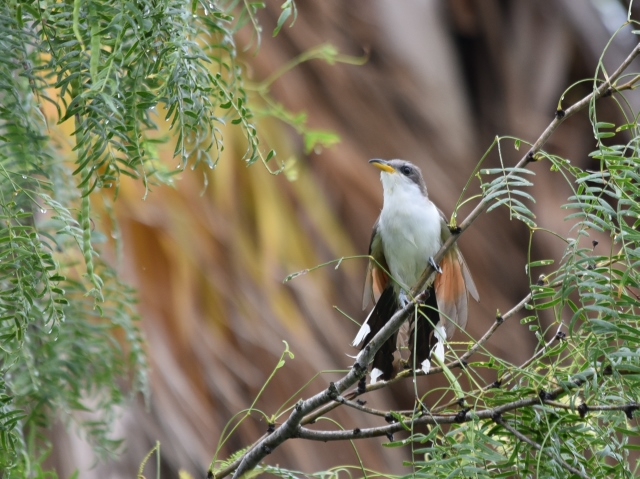Story by Anita Westervelt, Texas Master Naturalist

In the eerie stillness between late afternoon summer storms, I heard the soft guttural rattle of a rain crow — a vocal yet illusive summer visitor to our yard these past three or four years.
I raced to the house, grabbed my camera and swiftly swept back into the lower yard, my determined gaze intent on seeking this loyal yet secretive bird. And there it was — near the top of a tall mesquite tree, barely visible amongst the feathery green of the branch’s leaflets — and then, as luck would have it, the bird fluttered to a higher branch, now clearly visible against a distant, muted backdrop!
In the southern United States, words like portent, foreshadowing, omen, or augury — a practice from ancient Roman religion of interpreting omens from the observed behavior of birds — are often used in conjunction with tales about this rarely seen but oft heard mysterious bird whose calls on hot cloudy days often presage rain or booming thunderstorms.
In the Valley, especially during a drought, the rain crow’s rattle-purr-knock-knock-knock is a welcome sound, stirring hope in those who believe it to be a harbinger of rain.
Rain crow or storm crow, this reputed prognostic bird is the yellow-billed cuckoo (Coccyzus americanus). It is a summer resident in much of mid to eastern North America, preferring forests and riparian habitats with dense scrub brush. Mesquite trees are a favorite with our Valley visitors.
Yellow-billed cuckoos breed from southeast Canada to northern Mexico and the Caribbean. It is the only cuckoo species in Texas and can be seen from April through November. They migrate primarily to South America, especially Peru, Bolivia and as far south as northern Argentina.
The yellow-billed cuckoo’s preferred diet is caterpillars, especially hairy caterpillars, and cicadas; they also will eat snails, grasshoppers, crickets, small frogs and lizards as well as berries and some fruit. Females lay from two to five eggs, depending on the abundance of food.
Both male and female of the species may visit a prospective nest site. Both parents tend the nest, incubate eggs and protect the nests from predators.
In its swift flight from tree to tree, the bird’s dull white underparts often blend with a cloudy sky, making the bird inconspicuous but for its cinnamon-colored primaries and large white polka dots on the underside of its black tail.
For those who enjoy collective bird nouns, for cuckoos, it is an asylum of cuckoos; for baby cuckoos, an incredulity of cuckolds — which is attributed from the habit of female cuckoos laying eggs in other birds’ nests and leaving the babies to be raised by the adopting adults.
As exciting as it was to finally see the rain crow, I suspect it might be the culprit as to why some of the black and orange fuzzy caterpillars I’ve been tracking these past few weeks have disappeared before reaching their final caterpillar stage prior to transforming into a beautiful leopard moth or one of the other gorgeous tiger moths.
– 30 –
Animaldiversity.org, tpwd.gov, Wikipedia.org and “Smithsonian Handbooks, Birds of Texas,” Fred J. Alsop III, were helpful in writing this article.